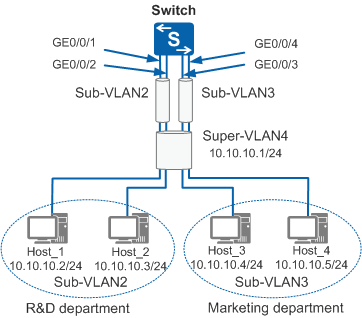Example for Configuring Inter-VLAN Proxy ARP
Networking Requirements
In Figure 1, the IP addresses of the hosts in the R&D and marketing departments belong to the same network segment but different VLANs. The enterprise requires that hosts in the two departments communicate with each other.
Configuration Roadmap
The configuration roadmap is as follows:
Configure a super VLAN and sub-VLANs, and add interfaces to sub-VLANs.
Configure IP addresses for VLANIF interfaces in the super VLAN and enable inter-VLAN proxy ARP.
Procedure
- Configure a super VLAN and sub-VLANs, and add interfaces to sub-VLANs.
# Create sub-VLAN 2 and add interfaces to sub-VLAN 2.
<HUAWEI> system-view [HUAWEI] sysname Switch [Switch] vlan batch 2 [Switch] interface gigabitethernet 0/0/1 [Switch-GigabitEthernet0/0/1] port link-type access [Switch-GigabitEthernet0/0/1] port default vlan 2 [Switch-GigabitEthernet0/0/1] quit [Switch] interface gigabitethernet 0/0/2 [Switch-GigabitEthernet0/0/2] port link-type access [Switch-GigabitEthernet0/0/2] port default vlan 2 [Switch-GigabitEthernet0/0/2] quit
# Create sub-VLAN 3 and add interfaces to sub-VLAN 3.
[Switch] vlan batch 3 [Switch] interface gigabitethernet 0/0/3 [Switch-GigabitEthernet0/0/3] port link-type access [Switch-GigabitEthernet0/0/3] port default vlan 3 [Switch-GigabitEthernet0/0/3] quit [Switch] interface gigabitethernet 0/0/4 [Switch-GigabitEthernet0/0/4] port link-type access [Switch-GigabitEthernet0/0/4] port default vlan 3 [Switch-GigabitEthernet0/0/4] quit
# Create super VLAN 4 and add sub-VLAN 2 and sub-VLAN 3 to super VLAN 4.
[Switch] vlan 4 [Switch-vlan4] aggregate-vlan [Switch-vlan4] access-vlan 2 [Switch-vlan4] access-vlan 3 [Switch-vlan4] quit
- Configure IP addresses for VLANIF interfaces in the super VLAN and enable inter-VLAN proxy ARP.
[Switch] interface vlanif 4 [Switch-Vlanif4] ip address 10.10.10.1 24 [Switch-Vlanif4] arp-proxy inter-sub-vlan-proxy enable [Switch-Vlanif4] quit
- Configure IP addresses for hosts.
# Assign 10.10.10.2/24 to Host_1.
# Assign 10.10.10.3/24 to Host_2.
# Assign 10.10.10.4/24 to Host_3.
# Assign 10.10.10.5/24 to Host_4.
- Verify the configuration.
# Check ARP entries of VLANIF 4 on the Switch. The command output shows the MAC address mapping the IP address of VLANIF 4.
[Switch] display arp interface vlanif 4 IP ADDRESS MAC ADDRESS EXPIRE(M) TYPE INTERFACE VPN-INSTANCE VLAN/CEVLAN ------------------------------------------------------------------------------ 10.10.10.1 101b-5441-5bf6 I - Vlanif4 ------------------------------------------------------------------------------ Total:1 Dynamic:0 Static:0 Interface:1
# Ping the IP address of Host_3 on Host_1 (using Windows 7 as an example). The ping operation is successful.
C:\Documents and Settings\Administrator> ping 10.10.10.4 Pinging 10.10.10.4 with 32 bytes of data: Reply from 10.10.10.4: bytes=32 time<1ms TTL=128 Reply from 10.10.10.4: bytes=32 time<1ms TTL=128 Reply from 10.10.10.4: bytes=32 time<1ms TTL=128 Reply from 10.10.10.4: bytes=32 time<1ms TTL=128 Ping statistics for 10.10.10.4: Packets: Sent = 4, Received = 4, Lost = 0 (0% loss), Approximate round trip times in milli-seconds: Minimum = 0ms, Maximum = 0ms, Average = 0ms# Check the ARP table on Host_1. The command output shows that the MAC address mapping the IP address of Host_3 is the MAC address of VLANIF 4 on the Switch, indicating that Host_1 and Host_3 can communicate with each other through proxy ARP.
C:\Documents and Settings\Administrator> arp -a Interface: 10.10.10.2 --- 0xd Internet Address Physical Address Type 10.10.10.4 101b-5441-5bf6 dynamic ...
Configuration Files
Switch configuration file
# sysname Switch # vlan batch 2 to 4 # vlan 4 aggregate-vlan access-vlan 2 to 3 # interface Vlanif4 ip address 10.10.10.1 255.255.255.0 arp-proxy inter-sub-vlan-proxy enable # interface GigabitEthernet0/0/1 port link-type access port default vlan 2 # interface GigabitEthernet0/0/2 port link-type access port default vlan 2 # interface GigabitEthernet0/0/3 port link-type access port default vlan 3 # interface GigabitEthernet0/0/4 port link-type access port default vlan 3 # return
